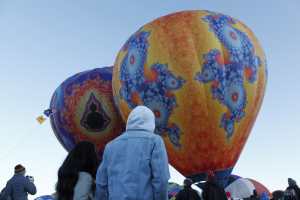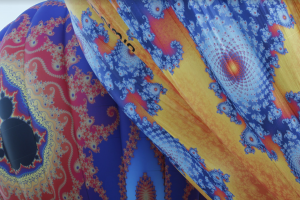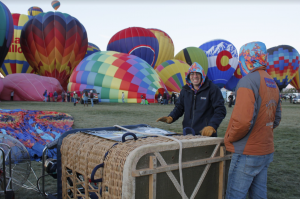By Sevia Gonzales / News Port
Albuquerque celebrated its renown as the hot air balloon capital of the world last month, drawing more than 800,000 visitors to the 2019 Albuquerque International Balloon Fiesta.
The festival featured hundreds of balloons, including two entries from the local Fractal Foundation, which uses fractal art to inspire interest in Science, Technology, Engineering, and Math.
Founded by Jonathan Wolfe in 2003, The Fractal Foundation has distinguished Albuquerque as the “fractal capital of the world.” Wolfe has combined the distinctions, creating the world’s first digitally printed fractal art balloons. He calls them Infinitude and Fibonacci.

Infinitude, piloted by Wolfe himself, debuted at the 2018 Balloon Fiesta. Fibonacci, Wolfe’s second mathematical artwork premiered this year and is piloted by “fractal ambassador” Jason Fischer.
Fibonacci is the largest high-resolution fractal ever printed, boasting 340 billion pixels on the massive envelope.
“With a fractal, there’s infinite resolution possible so we can render it at whatever scale we want and have it just super detailed,” Wolfe said. “My balloon has over 100 billion pixels in it, and I upped that with the new balloon.”
A fractal is an infinite, complex pattern that repeats at different scales, a property known as “self-similarity”. This means that fractals can be magnified or “zoomed into” infinitely with new details emerging at every scale.

Fractals can be produced using an algebraic formula, each result becoming a point in two-dimensional space, which is then visually represented by a fractal design. The designs for Infinitude and Fibonnaci are both variations of the Mandelbrot Set, only differing in the scale at which they are enhanced.
The Fractal Foundation partners with the Museum of Natural History to put on fractal zoom shows at the planetarium and runs a variety of educational outreach programming with the goal of inspiring students, educators and the general public with the beauty of science and math.
Since its conception, Wolfe said the organization has taught more than 70,000 kids and 600 educators about fractals. Their planetarium show has sold out at least 500 times, according to the Fractal Foundation’s website.
“That people want to come out to be entertained and amused and educated by fractals on a Friday night? To learn about algebra in a planetarium as a social event? That’s unheard of,” Wolfe said.
One of the Foundation’s goals is to make math and science cool, accessible and interesting to the general public, and Wolfe said the balloons are a novel and compelling way to foster enthusiasm.
“Math is an empowering tool… it also is a creative tool that lets you make unbelievably beautiful art works,” he said.

Growing up in Albuquerque, Wolfe said he has been captivated by hot air balloons and the mathematical patterns of fractals since he was a kid.
Wolfe said he spent years staying up to date on the latest state of the art printing technology and testing different vendors, only to be continuously disappointed with printing resolution and durability. Then, at the 2016 Balloon Fiesta, up-and-coming Czech Republic balloon manufacturer Kubiceck caught his eye.
He says Kubiceck’s manufacturing process is ideal for fractal printing — they use a dye sublimation process that chemically bonds the ink to their polyester balloon fabric, holding color steadfast, unlike the traditional, fade-prone nylon used by most vendors. This method also retains the design’s infinite resolution.
“It’s actually kind of like microscopic, computer-controlled, super-precise tie dye,” Wolfe said. “It doesn’t add any weight to it either.”
Wolfe said he spent between three and four months on the individual fractal designs for both Infinitude and Fibonacci. Both art works were created using advanced computer programming and fractal generators.
“I’ll zoom into a fractal on a computer using… a fractal explorer program,” he said. “I will try to find some kind of symmetries or patterns that I can map onto a balloon envelope.”
Once he finishes his two dimensional fractal designs, he slices them into thin pieces and maps them onto a 3D model of the balloon envelope, creating a low-resolution prototype laying out the fabric panels or gores. This design is sent to Kubiceck in the Czech Republic where the balloon envelope is printed and hand sewn together.
All told, Wolfe said the process costs about $85,000. This includes a $15,000 Fractal Foundation design charge, Kubiceck’s $25,000 printing and production fee, the cost of the basket, fuel tanks and any other à la carte modifications.
Premiering two, one-of-a-kind art balloons in two years seems appropriate, as fractals patterns repeat in a doubling fashion.
“Given the nonlinear nature of fractal mathematics, my running joke now is that two fractal balloons are four times as cool,” Wolfe said.
Wolfe said he wants to continue the pattern in the coming years and is hoping to bring four balloons to next year’s Fiesta, pending financial backing. He says he’s confident that funding for more Flying Fractals will appear.
“This is exponential growth,” Wolfe said. “Before I die I want to have at least 100 flying artworks in the sky.”
In the meantime, Wolfe’s designs can be seen at the planetarium’s live fractal shows on the first Friday of every month.
Sevía Gonzales is a reporter for the New Mexico News Port. She can be reached on Twitter @GonzalesSevia or at nmnewsport@gmail.com.